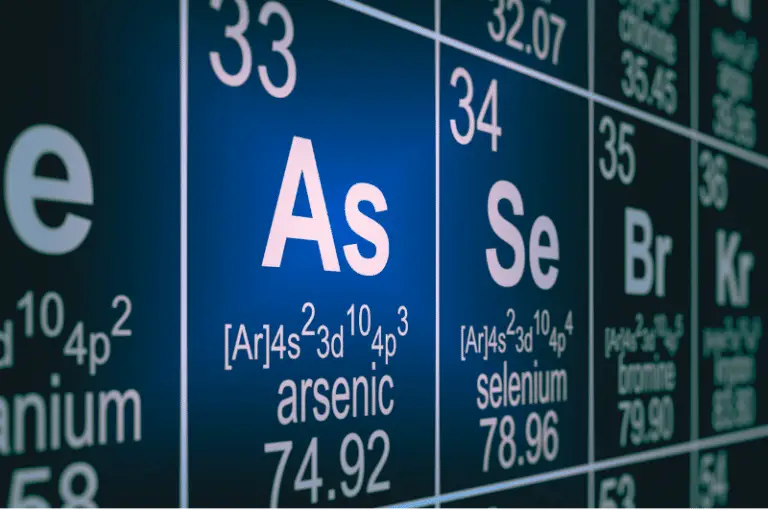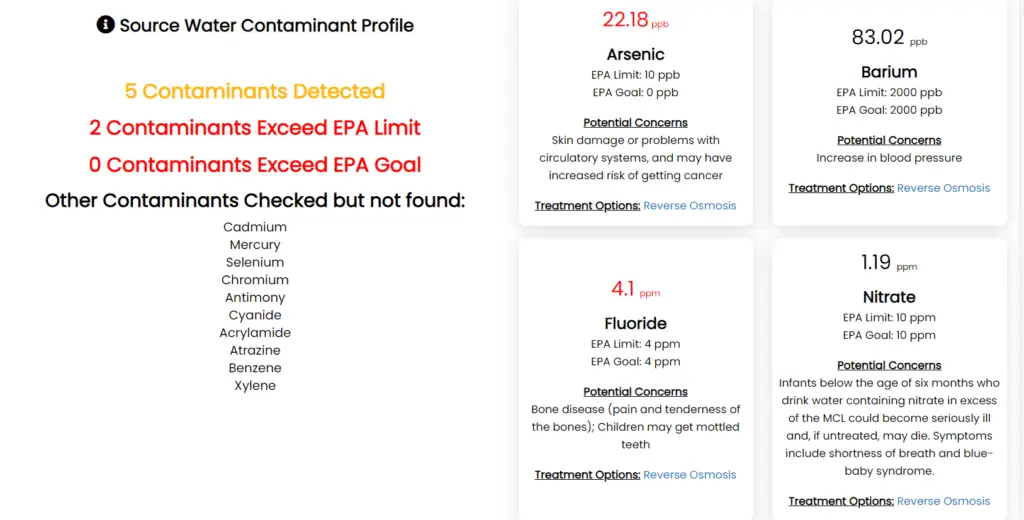How to Filter Arsenic From Drinking Water At Home
- by Ryan Moreau / updated April 23rd, 2024
Arsenic is a common water contaminant that occurs in natural deposits within the earth’s crust. Drinking water derived from groundwater sources typically see the highest concentrations of arsenic. A national study conducted by the United States Geological Survey found that arsenic was detected in nearly half of the wells samples at 1 ppb or greater, exceeding the US EPA’s health goal of 0 ppb. The study also reported that 7% of well water exceeded the EPA’s legally enforceable limit of 10 ppb.
On a large scale, arsenic is difficult and expensive to remove from our drinking water supply. As a result, the EPA allows arsenic to exist in drinking water above their recommended health guidelines of 0 ppb. Arsenic can exist in drinking water up to 10 ppb before the EPA requires public water systems to take action to reduce this contaminant. Homeowners who have a private well are at an even greater risk of arsenic contamination.
If your source water contains arsenic, you can be certain that arsenic exists in your drinking water in some concentration. To determine the average arsenic concentration in your source water, click here.
In this article, we’ll delve into the significance of arsenic in water, its sources, and, most importantly, how to test for it and filter it.

Contents
What is arsenic
Arsenic is a chemical element with the symbol “As” and atomic number 33 on the periodic table. It is a naturally occurring element typically found in combination with other elements in various minerals and heavy metals.
Elemental arsenic has several forms, ranging from highly toxic to relatively less toxic.
The two primary types of arsenic are inorganic and organic arsenic. For drinking water, we are primarily concerned with inorganic arsenic. Inorganic arsenic is the more toxic form of arsenic and includes arsenite (Arsenic 3) and arsenate (Arsenic 5).
Arsenic 5 is much easier to remove with common household filtration options, while Arsenic 3 is much more challenging.
Industrial applications, such as pesticides, wood preservatives, and glass production, have used arsenic in the recent past. However, many of these uses have been restricted or banned due to arsenic’s health and environmental risks.
In high concentrations, arsenic is a potent poison that can cause various health problems, including discoloration of the skin, heart disease, respiratory problems, and an increased risk of skin cancer and cancer of the bladder, according to the World Health Organization. Chronic exposure to even low levels of arsenic in drinking water can have serious long-term effects.
We have no control over the levels of arsenic in our environment, but we do have control over the arsenic levels in the water we drink.
How does arsenic get into water
Arsenic finds its way into water sources through natural processes and human activities. Natural sources include the erosion and dissolution of minerals containing arsenic in rocks and soil, leading to its presence in groundwater and surface water.
Human activities such as mining, industrial processes, and improper waste disposal can significantly contribute to arsenic contamination. Some states have naturally higher levels of arsenic in the ground, leading to increased concentrations in local water sources.
While higher concentrations of arsenic are typically found in drinking water that uses groundwater as its source, surface water is also at risk for contamination. Private well owners should be extra diligent with routine testing to ensure their wells aren’t heavily contaminated with this dangerous element. City water users should also know where their drinking water comes from and review their city’s local consumer confidence report.
Below is an example of a Taptool water quality report showing very high fluoride levels and arsenic levels in city water that draws from a groundwater source. The levels shown in the source water in this example exceed the EPA’s Maximum Contaminant Level of 10 ppb for arsenic. Compare your local water quality results with your public water systems consumer confidence report and conduct additional testing as needed to verify the levels. This will help you make an informed decision if additional filtration is necessary.

How To Test For Arsenic in Water at Home
The best way to determine if your water contains arsenic is to have it tested. Water testing is extremely important if you own a private well because the EPA does not monitor wells. It is commonly recommended to have your well tested annually for various contaminants, including arsenic.
For the simplest method, you can use at-home arsenic test kits. These kits are cheap and accurate enough to give you a good idea of the arsenic levels in your water. The disadvantage of these at-home water tests is that they measure total arsenic and do not differentiate between arsenic 3 and arsenic 5. This is an important distinction when deciding what filtration equipment you need to remove arsenic.
To determine the form of arsenic, you will need to send your samples to a certified lab. This is the most accurate and comprehensive method for testing your water. Several packaged testing options allow you to test for several contaminants, including arsenic.
Without doing any testing, the best method for private well owners to get some idea of their average arsenic levels is to look at local groundwater data from the USGS. We compiled this data for arsenic and several other contaminants here, and it is searchable simply by entering your zip code. The arsenic level reported is the historical average provided by USGS within a 25-mile radius of your zip code.
This tool is also an excellent resource for city water. For our complete guide on water testing, click here.

How to Filter Arsenic from Water
Removal of arsenic is highly dependent on what form it is in. Arsenic 5 can be removed relatively easily using an inexpensive arsenic water filter. Arsenic 3, however, is more difficult to remove and requires oxidation to convert arsenic 3 to arsenic 5.
The methods and water filters described below will help you determine the best arsenic removal system for your home.
Reverse Osmosis (RO)
Reverse Osmosis is effective in removing both forms of arsenic. RO systems use a semipermeable membrane to filter out arsenic ions and other contaminants from water. Reverse Osmosis removes 98% of arsenic 5; however, it only removes about 50-80% of arsenic 3. For higher removal rates, arsenic 3 would have to be oxidized to arsenic 5 using an oxidant such as chlorine. Reverse osmosis systems are the most common filters used for point-of-use treatment of arsenic.
Oxidation
Oxidation is used to convert the more difficult-to-remove arsenic 3 to arsenic 5. Once oxidized, arsenic 5 can be removed through various filtration options. Common oxidizing agents include chlorine, ozone, and potassium permanganate. If you are on city water, you can be certain that all of the arsenic is likely in the arsenic 5 form as city water is chlorinated to prevent biological growth.
Activated Alumina
A common method to remove arsenic is using an activated alumina filter. This option is most commonly used as a whole-house filtration option for removing arsenic at the source. The activated alumina is impregnated with iron, which works as an adsorbent to bind the arsenic ions, effectively removing them from the water. Activated Alumina does not readily remove arsenic 3; pre-oxidation would be required with high levels of arsenic 3.
Ion Exchange
Ion exchange resins can remove arsenic 5 by replacing the arsenic ions with other ions adsorbed on resin beads. This method is less commonly used for arsenic 3 and pre-oxidation is required to convert arsenic 3 to 5.
Distillation
Distillation can be an effective method to remove a wide range of contaminants found in water, including all forms of arsenic. Distillation works by heating water to create steam, leaving contaminants behind, and then cooling the steam to condense it back into purified liquid water, effectively separating and removing contaminants. This method will remove 100% of both arsenic 3 and arsenic 5.
If you have any further questions about arsenic in water, please feel free to Contact Us.
